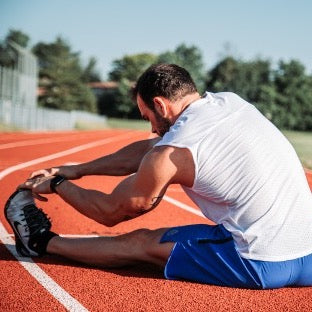
The Top 8 Benefits of Stretching

The perspective that stretching is only reserved for the fittest, that couldn’t be further from the truth. In fact, even the most sedentary of individuals could benefit from stretching.
In this article, we’re going to be discussing the importance of stretching, the benefits of stretching, and how YOU can implement an effective and intentional stretching routine into your daily life!
The Importance of Stretching
The need to understand the value of mobility and flexibility when it comes to one’s health and well-being is imperative.
Whether you’re sedentary, injured, or old, one’s ability to move functionally has a finite lifespan, only shortening if we don’t act proactively. This is where the importance of stretching comes in to play.
Stretching increases range of motion, improves flexibility, creates muscle pliability, strengthens and elongates muscle fibres, improves the health of joints, ligaments, and tendons, reduces pain and tightness, and can even have an impact on one’s quality of life.
Becoming functionally fluid with your movement via a consistent and effective stretching routine is vital to your health & well-being. Gone are the days where stretching is overlooked. In order for it to be effective, however, it needs to be implemented and acted upon on a daily basis indefinitely.
The Top 8 Benefits of Stretching
The importance of stretching, whether you’re an elite athlete or regular Joe or Jane, is undeniable. Below are some of the top benefits of stretching that directly translates to a better quality of life:
- Reduces Pain & Inflammation
- Minimizes Muscle Soreness
- Increases Mobility & Flexibility
- Improves Range of Motion
- Reduces Risk of Injury
- Decreases Stress
- Improves Blood Flow & Circulation
- Relaxes the Mind
Reduces Pain and Inflammation
Tight muscles can cause injury and chronic pain. By elongating and strengthening these muscles via a regular stretching routine, you can help alleviate and heal such pain.
Minimizes Muscle Soreness
Similar to pain, muscle tightness and tension can cause soreness/stiffness. By implementing a consistent stretching routine, you help alleviate and potentially eliminate soreness & stiffness.
Increases Mobility & Flexibility
As we age, we hope to be able to remain active so that we can care for ourselves, enjoy the freedoms of life, and enjoy time with our kids and grandkids. Stretching directly improves ones flexibility so that you can remain active and fit well into your older age.
Improves Range of Motion
A regular stretching routine not only improves flexibility but it can drastically improve joint-health, ultimately resulting in an improved range of motion. Having an optimal range of motion plays into performance, both in the gym and in daily life.
Reduces Risk of Injury
Injury occurs when muscles, joints, and/or tendons are compromised. Your muscles, joints, and tendons become more vulnerable if you don’t care for them. While you can’t directly prevent injury, you can certainly reduce the risk by stretching.
Decreases Stress
Much like physical stress, mental stress can derive from physiological tension. A regular stretching routine, however, has been shown to reduce anxiety, depression, and improve overall mindfulness, ultimately relieving yourself of stress.
Improves Blood Flow & Circulation
Stretching enhances the transportation and movement of oxygen and blood through the body. Improved blood flow can result in reduced soreness and shorter recovery times, among other things.
Relaxes the Mind
Stretching and other flexibility routines don’t only benefit the physical. A regular routine can also provide meditative benefits. Give your mind a daily mental vacation and begin your stretching journey today!
How to Implement an Effective Stretching Regimen
There are two types of stretching available to you, generally speaking. While there are a number of stretching methodologies out there, we’re only going to be focusing on the main two:
- Dynamic
- Static
Dynamic Stretching
Dynamic stretching, otherwise known as “active” stretching, is typically utilized as a means of warming up, or priming the body for action. Dynamic stretches are not held for an isolated amount of time, but are instead used in flow. Examples of dynamic stretches are:
high knees, butt-kicks, shoulder circles, hamstring sweeps, and bodyweight lunges, just to name a few…
Static Stretching
Static stretching is typically utilized post-workout in order to minimize or reduce delayed onset muscle soreness, stiffness, and risk of injury. This type of stretching is held in isolation for a duration of usually 15-30 seconds or more.
Examples of static stretches are: held toe-touches, wall calf stretch, isolated tricep stretch, seated butterfly, and cobra pose, just to name a few…
Prior to engaging in an exercise, your muscles and joints are cold and stiff. By participating in a dynamic warm-up, you increase body-temperature, awaken your muscles, and create blood flow to your extremities. This will prepare you for exercise. Upon completion of the exercise, stretching statically will ensure proper recovery.
So, where do you start?!
It can definitely be a challenge to begin, especially for those that have never done so before. It’s an overwhelming thought to think that you must stretch every muscle and fibre in your body in order to live a long and healthy life.
However, rest assured that this isn’t the case.
It’s all about just taking the first step. Begin with a 10 minute static stretching routine 2-3 days per week. Once you have become accustomed to the idea of stretching, begin to increase the duration and time spent stretching.
The ultimate goal is to make a habit of dynamically warming up before every workout, and statically stretching post workout to cool down and recover.
If you have any chronic or acute injuries, diseases, disorders, or other medical conditions and you are concerned about starting, it is highly recommended that you consult with your doctor prior to any implementation of a stretching routine.
Stretching doesn’t have to be an intimidating activity, but instead should be approached as a liberating one. It doesn’t have to be exhaustive either! The important thing is that you just start. The importance of stretching is vast, and the benefits that you will experience are many. Start today.






